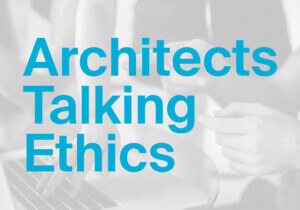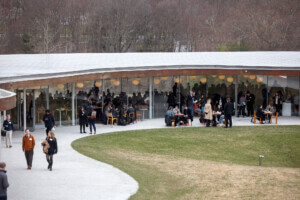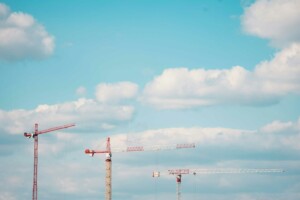For the duration of the coronavirus (COVID-19) crisis, AN will use this column to keep our readers up to date on how the pandemic is affecting architecture and related industries. This weekly article is meant to digest the latest major developments in the crisis and synthesize broader patterns and what they could mean for architecture in the United States.
It’s now been over one week since the first state in the U.S., California, enforced a shelter in place order, disrupting the working lives of millions of Americans. The pandemic’s impact on architecture still isn’t totally clear; some construction sites are closed, financial markets are fluctuating, and designers are working from home, but whether or not the country is headed toward a long-term recession or whether it will bounce back once the acute period of the crisis passes is an open question. I spoke with Jonathan Moody, CEO of Ohio-based Moody Nolan, about how the pandemic is affecting his business and the industry more broadly.
“We’re hoping for the best but planning for the worst,” Moody said. Lessons from 2008’s Great Recession are coming in handy, he said, particularly lessons about the value of diversifying project types and being aware that different sectors of the industry will fare differently. Education projects may be hampered by schools suddenly without students (the pandemic has spurred the San Francisco Art Institute to close permanently), while multifamily housing may see boosts from slashed interest rates. He also suggested that because construction timelines on large institutional projects are so long, a few weeks of interruption would pass relatively quickly and wouldn’t require firms to cut staffing.
The past few weeks have brought a jarring amount of change. Multiple architecture events have been postponed or canceled. The AIA has indefinitely postponed its annual conference, originally scheduled for mid-May in Los Angeles; Milan’s Salone del Mobile moved from April to June, before being canceled and moved to 2021; New York Design Week events have been pushed to October from May; and the Venice Architecture Biennale, also originally planned for May, will now open in August. Cultural institutions have started to feel the squeeze as they close or attendance plummets. Of course, there is also the human toll of the pandemic, visible in the death of Italian architect, planner, editor, and curator Vittorio Gregotti, who died of complications related to COVID-19 infection at the age of 92, and the death of theorist and the director emeritus of Graduate Urban Design Program of the City College of New York, Michael Sorkin.
The profession’s day-to-day operations, for the most part, continue to go on, albeit in modified forms. Shelter in place orders mean that in architecture offices in hubs like New York, Chicago, and Los Angeles, employees are working from home and teleconferencing their way through the day (although WeWork refuses to close), but those same restrictions haven’t affected construction sites in the same way. Tradespeople continue to show up to sites across most of the country, even in places where office workers are staying home, although that is slowly changing. Construction Dive published an interactive map to keep track of construction-site closures across the country, which began in Boston and have slowly spread elsewhere. Some manufacturers have had to temporarily close factories because of shelter in place rules—Michigan’s many furniture producers had to pause work after that state’s social distancing order took effect on Tuesday—and some products from China and Italy are now less readily available.
Moody said that, so far, material and product supply chain delays had caused only a few minor hiccups to schedule, but had encouraged the company to think more about the necessity of items coming from halfway around the world. “Some of these products look really nice, but are they essential?” he said. Given that occupancy permits may be delayed because of a missing lightbulb from China, shipments of which may be delayed because of the pandemic, “we have to be a little more thoughtful about where [products] are coming from.” Memories of these supply chain disruptions may drive designers to source products and materials more locally even after the pandemic recedes.
The crisis may also spur changes in how the broader public thinks about land use. Outdoor spaces are getting new attention. Inga Saffron wrote in The Philadelphia Inquirer about how parks have become overcrowded refuges for cooped-up urbanites, and New York City is starting to close a couple of major streets in all of its boroughs to open up more space for exercise and recreation as vehicle traffic plummets. Shelter in place orders are also shining a light on the fact that many city dwellers don’t have a safe shelter to go to, and protesters in Southern California have occupied vacant homes to find housing that the government has not been able to provide. The explosion of cases is forcing cities to get nimble: New York is scrambling to convert spaces like the Javits Center to temporary treatment centers as the city runs out of hospital beds. Curbed wrote about how, like in past pandemics that have shaped the design of cities like New York, COVID-19 may be an inflection point in how urbanists plan our metropolises.
The crisis could also spur changes to construction technology, encouraging contractors to adopt tools that could decrease the number of people on-site, like site-monitoring drones or robotic delivery. Moody said that his firm’s move toward state-of-the-art teleconferencing techniques a few months ago now seems prescient and is helping the company weather the crisis. Similar forward-thinking about construction sites might be what gets the industry through this or coming crises.
While it’s easy to feel bogged down by the daily onslaught of news, Moody stressed the importance of looking ahead. “We do know that this won’t last forever,” he said, “and the things that we’ve been working on will need to continue when ready.” In the meantime, he is seeing some upsides to the interruptions to normal work routines. “[The disruptions are] forcing us to really question what is essential and teaching us what is important. We’ve seen our staff and clients be more decisive and thoughtful about how to best leverage expertise, maximize value, and treat people the right way. We’re seeing our humanity on display, and we’re not ashamed to show that we care for one another.”
And while you are stuck inside, there are some virtual ways to get out of the house and explore. Google has compiled over 500 virtual tours of museums from around the world; staff at the Museum of Modern Art have put together a list of movies and video art to stream; filmmaker Gary Hustwit’s design movies, like Helvetica and Urbanized, are available for free streaming; and schools including the University of Southern California are streaming their spring events online. I also recommend this history of the N95 mask if you’re looking for a good long read.
Finally, if you’re able to help and are looking for opportunities, check out Invisible Hands, an organization pairing people who can’t leave their homes with others who can deliver their groceries or run errands.
Be well!











